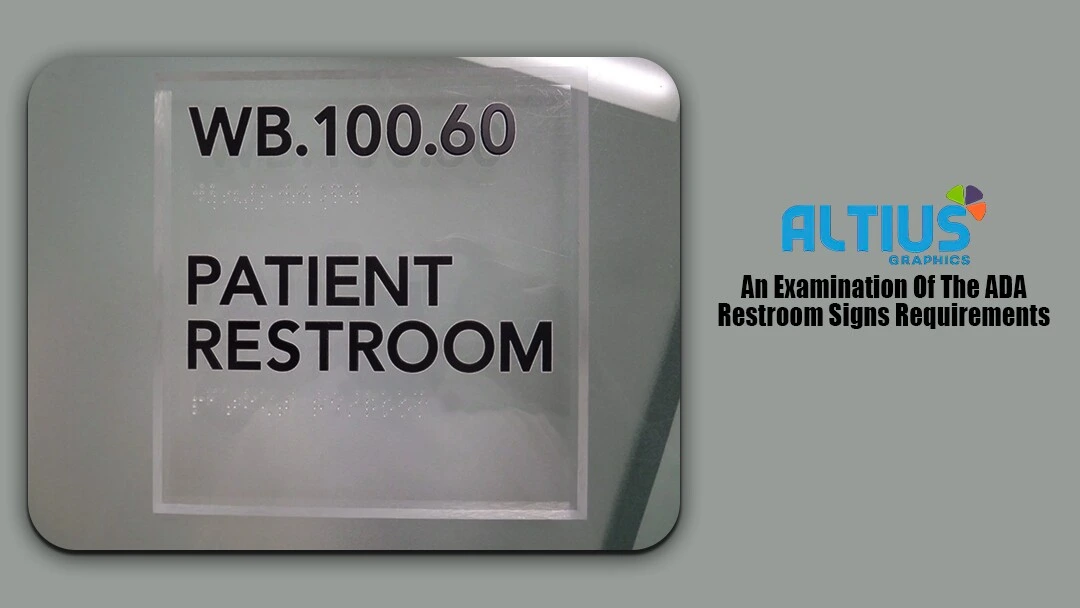ADA Restroom Signs are required to assist those with visual impairments in finding the appropriate restroom. Restroom signs give visitors/ guests to any building the peace of mind that they will find the necessary facilities. In addition to comfort and convenience, restroom signs are carefully regulated to ensure that all guests, even those with disabilities, can locate facilities. Building owners must understand the rules governing restroom signs because failure to do so can result in severe penalties.
Businesses and building managers (as well as sign fabricators) are strongly encouraged to follow ADA restroom sign requirements, but this can be difficult if you are unfamiliar with the criteria that signage must meet—particularly when it comes to ADA-compliant restroom signs.
Before delving into the specific features that a display must have to be ADA compliant, it’s worth discussing why it all matters.
Why are restroom signs required?
Restroom signs, like other signs in public buildings, must follow both state and federal regulations. However, because the American Disabilities Act governs restroom signs, the requirements are even stricter (ADA). Failure to comply can result in significant penalties from the ADA, which can increase depending on how many times the building or business is cited. Any guest who believes the signage is insufficient for their needs may report noncompliance to the building.
If you’re looking to buy new restroom signs for your facility, make sure they follow all of the rules and regulations outlined in the Americans with Disabilities Act for signs (ADA).
These ADA restroom sign requirements exist to ensure that people with disabilities have equal access to buildings as everyone else.
Obtaining signage that does not meet the ADA’s criteria puts you at risk of a variety of problems…
- Visitors with visual impairments may be unable to find their way around your facility, resulting in frustration on their part and a loss of business on yours.
- If a person believes their access to your building is restricted due to a lack of proper signage, you may face a lawsuit.
- If your building is subjected to a routine inspection, you could face a hefty fine for failing to have ADA-compliant restroom signs in place.
- Above all, you should strive to comply with ADA restroom sign requirements.
Making Certain ADA Restroom Signs Are Compliant
Restroom signs are subject to a slew of regulations designed to ensure that all visitors to any building, regardless of language or disability, can find facilities quickly and easily. It is now even more important to properly label restrooms so that guests, regardless of gender identity, can find the correct restroom.
Color and Contrast: While there is no single color for restroom signs, regulations require the lettering to stand out in strong contrast from the sign’s background to make it easy to read. Dark backgrounds, for example, should have light letters, and light backgrounds must have dark letters. The finish must also be non-glare.
Characters: To ensure easy reading from a distance, lettering must adhere to specific size guidelines. Number and letter characters must also be proportionate to one another. According to ADA guidelines, only a few different fonts are permitted.
ADA Braille: Any tactile signage must also include Braille restroom signs. Unless a proper name is included or a letter accompanies a room number, Grade 2 braille should be used in all lowercase.
Any letters and numbers in upper case, sans serif, or simple serif fonts must be raised by 1/32 inch and accompanied by Grade 2 Braille. All raised characters must be at least 5/8 inch (or 16 mm) tall, but no taller than 2 inches (50 mm). Pictograms on restroom signs should be accompanied by a verbal description of the image. The pictogram’s border dimension should be at least 6 inches (152 mm) tall.
Accessibility: If the restroom allows for it, restroom signs should include accessibility for disabled guests. To make them easily identifiable, they should display the international symbol of accessibility.
Restroom signs should comply with state and local regulations in addition to ADA guidelines. California buildings should be especially aware of these requirements, as the state has some of the strictest ADA signage regulations in the country.
How Should Restroom Signs Be Mounted?
There are rules for how ADA restroom signs should be designed, as well as guidelines for how the signs should be mounted. Mounting regulations include the following:
Location: Signage should be placed on the side of the door with the handle or latch. Signs must be posted on the closest wall if it is a double door.
Height: Restroom signs must be 60 inches tall from the floor to the center of the sign.
Obstruction: Restroom signs should be mounted so that a person can approach within three inches of the sign without colliding with objects or blocking the door.
Now that you understand why you should take care to meet all ADA restroom sign requirements.
ALTIUS Graphics is specialized in ADA and Wayfinding Signage.



